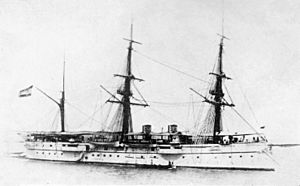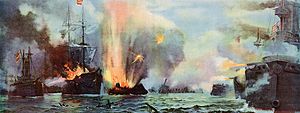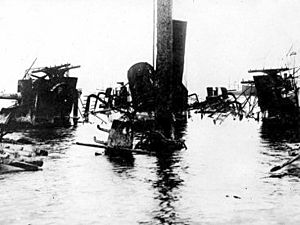Spanish cruiser Castilla facts for kids

Castila
|
|
Quick facts for kids History |
|
|---|---|
| Name | Castilla |
| Namesake | Castile, an historical region of Spain |
| Ordered | 1869 |
| Builder | La Carraca shipyard, Cadiz, Spain |
| Laid down | May 1869 |
| Launched | August 1881 |
| Completed | 1881 or 1882 |
| Commissioned | 1882 |
| Fate | Sunk 1 May 1898 |
| General characteristics | |
| Class and type | Aragon-class unprotected cruiser |
| Displacement | 3,289 tons |
| Length | 236 ft 0 in (71.93 m) |
| Beam | 44 ft 0 in (13.41 m) |
| Draft | 23 ft 6 in (7.16 m) maximum |
| Installed power | 1,400 ihp (1,000 kW) |
| Propulsion | 1-shaft, 3-cylinder, horizontal compound |
| Sail plan | Barque-rigged |
| Speed | 14 knots (26 km/h; 16 mph) |
| Complement | 392 officers and enlisted |
| Armament |
|
| Notes | 460 tons of coal (normal) |
The Castilla was a Spanish Navy warship. It was a type of ship called an Aragon-class unprotected cruiser. The Castilla is famous for its role in the Battle of Manila Bay. This battle happened during the Spanish–American War.
The ship was built in Cadiz, Spain. Its construction started in 1869. At first, it was meant to be an armored ship. But in 1870, the design changed to an unprotected wooden cruiser. Political events caused delays. The Castilla was finally launched in 1881 and finished in 1882.
Before the war, the Castilla helped patrol the Philippines. It tried to stop illegal goods from reaching Filipino rebels. It also supported the Spanish Army fighting on land. When the Spanish–American War began in April 1898, the Castilla was part of a Spanish fleet. This fleet was led by Rear Admiral Patricio Montojo y Pasarón in Manila Bay. The Castilla was sunk during the Battle of Manila Bay.
Contents
Ship Design and Features
The Castilla was built in Cadiz, Spain. Its construction started in 1869. The first plan was for an armored ship. It would have had thick armor on its sides. But in 1870, the design changed. It became an unprotected wooden cruiser.
This change meant the ship ended up with a very heavy wooden hull. By the time it was launched in 1881, this design was already old. The Castilla had two funnels and sails like a barque. Its engines were made in Ferrol.
The ship's main guns were old when it was finished. They were quickly replaced with newer ones. The Castilla was designed for duty in colonies. This included stopping illegal trade and pirates. It was not built to fight strong, armored warships. But that is exactly what it faced in the Battle of Manila Bay.
Ship's Service History
The Castilla officially joined the Spanish Navy in 1882. For its first few years, it stayed in Spanish waters. It was part of the Navy's training group. It also made visits to ports in the Mediterranean Sea.
In 1890, the Castilla joined a special naval group. This group was sent to strengthen the Spanish fleet in the Philippines. The ships sailed from Cadiz, Spain. They traveled through the Mediterranean Sea, the Suez Canal, and the Indian Ocean. They arrived in Manila on June 17, 1890. This was the first time the Castilla had sailed so far from home. In the Philippines, this group of ships was called the "Black Squadron." This was because they were painted black, unlike other ships.
After 1890, the Castilla stayed in the Philippines. From 1896 to 1897, the Philippine Revolution was happening. The Castilla patrolled the waters. It tried to stop supplies from reaching the Filipino rebels. It also helped the Spanish soldiers fighting on land in Cavite Province.
The Spanish-American War
When the Spanish–American War started in April 1898, the Castilla was in Manila Bay. It was part of Rear Admiral Patricio Montojo y Pasarón's fleet. On April 25, 1898, the Castilla and five other ships sailed to Subic Bay. Admiral Montojo hoped to use underwater mines and shore guns there.
During the trip, the Castilla started leaking water. Its engines were already in bad shape. To stop the leak, the crew had to plug the hole with concrete. This made the ship unable to move on its own. So, Montojo's main ship, the Reina Cristina, had to tow the Castilla.
When they got to Subic Bay, the mines and shore guns were not ready. So, on April 29, 1898, Montojo's ships went back to Manila Bay. The shore guns there could help protect them. Also, the water was shallow, which might save lives if ships sank. The Castilla was again towed by the Reina Cristina. The fleet anchored near Cavite Peninsula. Small boats and barges were tied to the Castilla's wooden hull. This was to protect it from enemy fire. Sandbags were also placed along the side facing the enemy.
At 4:00 AM on May 1, 1898, Admiral Montojo told his ships to get ready for battle. The U.S. Navy's fleet, led by Commodore George Dewey, was seen approaching at 4:45 AM. The Castilla and other Spanish ships started firing at 5:20 AM. This began the Battle of Manila Bay. It was the first big battle of the Spanish–American War.
Dewey's ships slowly sailed past the Spanish fleet, firing their guns. The Castilla could not move. It had to fight while anchored. It was still painted white with yellow funnels, making it an easy target. At 6:30 AM, an American shell hit the Castilla. It disabled two of its guns and killed several crew members. American shells also cut its anchor cables. The ship then drifted, showing its unprotected side to Dewey's fleet.
Three large shells hit the Castilla and started a big fire. By 7:15 AM, the fire was destroying the ship's deck. At 8:30 AM, the crew was ordered to leave the ship. Another Spanish ship, the Don Juan de Austria, helped rescue the crew.
The Castilla was hit by many shells. It soon sank and was completely destroyed. About 23 to 25 men were killed, and 80 were wounded during the battle.
Trophy Cannon
In 1902, one of the guns from the Castilla was given to the city of Rochester, New York. It is now in Highland Park in Rochester. The Vermont State House also has two of these same cannons. They are on the front lawn.
Images for kids
See also
 In Spanish: Castilla (1886) para niños
In Spanish: Castilla (1886) para niños






